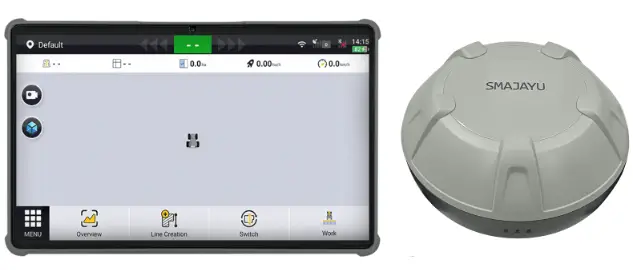
Hoʻolauna Huahana
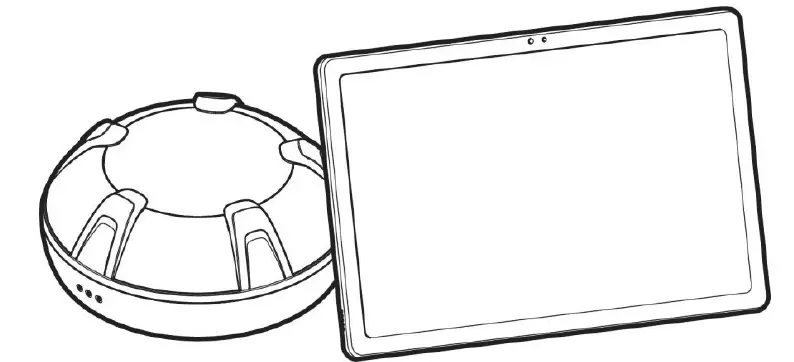
Agricultural Guidance System a kit that uses the PPP, SBAS, or RTK positioning technology to provide precise positioning and guidance for manual driving. By providing operation path planning and real-time navigation, Agricultural Guidance System helps agricultural machinery operators work with a higher accuracy. This system consists of a terminal, a GNSS receiver, and wiring harnesses. The terminal is installed with SMAJAYU · own navigation software.
Hoʻomākaukau ma mua o ke kau ʻana
Nā ʻōlelo aʻoaʻo palekana
Ma mua o ka hoʻokomo ʻana, e heluhelu pono i ka ʻōlelo aʻo palekana i loko o kēia manual e pale aku i ka hana ʻino i nā kānaka a me nā mea hana.
Nānā that the following safety advice cannot cover all possible dangerous situations.
Hoʻokomo
- Mai hoʻokomo i nā mea hana i loko o nā kaiapuni me ka wela kiʻekiʻe, ka lepo kaumaha, nā kinoea ʻino, nā mea puhi ahi, nā mea pahū, nā mea hoʻopili electromagnetic (no example, around large radar stations, transmitting stations, and substations). unstable voltages, haalulu nui, a me ka walaau ikaika.
- Mai hoʻokomo i nā mea hana ma nā wahi e hōʻiliʻili ai ka wai, e kahe, e kulu, a e hoʻopū.
Ka Mahina
- After installation, do not frequently disassemble the equipment; otherwise, the equipment can be damaged.
- Before disassembly, turn off all power supplies and disconnect the cable from the battery to avoid equipment damage.
Electrical Operations
- Pono e hana ʻia nā hana uila e nā limahana kūpono e like me nā kānāwai a me nā kānāwai kūloko.
- E nānā pono i ka wahi hana no nā pōʻino, e like me ka lepo pulu.
- Ma mua o ka hoʻokomo ʻana, e aʻo e pili ana i ke kūlana o ke pihi hoʻomaha pilikia. E hoʻohana i kēia pihi e ʻoki i ka lako mana inā loaʻa nā ulia.
- Ma mua o ka ʻoki ʻana i ka lako mana, e hōʻoia i ka pio ʻana o nā mea hana.
- Do not put the equipment in a humid place. Prevent liquids from entering the equipment.
- Keep it away from high power wireless equipment such as wireless transmitters, radar transmitters, high frequency and current devices, and microwave ovens.
- Hoʻopili pololei a pili ʻole paha me ka vol kiʻekiʻetage or utility power may cause death.
Requirements for Installation Site
No ka hōʻoiaʻana i ka hana maʻamau o nā mea hana a hoʻolōʻihi i kona ola lawelawe, pono ka pae hoʻonohonoho e hoʻokō i nā koi.
Kūlana
- E hōʻoia i ka paʻa o ke kūlana hoʻokomo e kākoʻo i ka pahu hoʻomalu a me nā mea pono.
- E hōʻoia i ka lawa o ka manawa e hoʻokomo ai i ka pahu hoʻomalu ma ke kūlana hoʻonohonoho, me kekahi wahi i hoʻokaʻawale ʻia ma kēlā me kēia ʻaoʻao no ka hoʻopau ʻana i ka wela.
Ka Mahana a me ka Humidity
- Pono e mālamaʻia ka mahana a me ka haʻahaʻa o ka hana hana i loko o kahi kūpono kūpono e hōʻoia i ka hana maʻamau a me ke ola lawelawe o nā mea hana.
- E pōʻino nā mea hana inā hana ia ma lalo o ka mahana a me ka haʻahaʻa o ke kaiapuni.
- Ke kiʻekiʻe loa ka haʻahaʻa haʻahaʻa, ʻaʻole hiki ke hana maikaʻi nā mea insulating, e hoʻoheheʻe ʻia nā au. Hiki ke hoʻololi i ka waiwai mechanical, ka ʻōpala, a me ka ʻino.
- Ke haʻahaʻa loa ka haʻahaʻa haʻahaʻa, maloʻo nā mea insulating a ʻokiʻoki, a hiki mai ka uila paʻa a hōʻino i nā kaapuni uila o nā mea hana.
Ea
Ensure that the contents of salt, acid, and sulfide in the air are within a reasonable range. Some hazardous substances will accelerate the rusting and corrosion of metals and the aging of parts. Keep the working environment free of harmful gases (for example, sulfur dioxide, hydrogen sulfide, nitrogen dioxide, a me ka chlorine).
Lako ikehu
- Voltage input: The input voltage of Agricultural Guidance System should be in the range of 12 V to 24 V.
- Connect the power cable to the positive and negative electrodes correctly and avoid direct contact of the cable with hot objects.
Mea Hana Hoʻokomo
E hoʻomākaukau i kēia mau mea hana ma mua o ke kau ʻana.
| Mahiai alakai Pūnaehana Hoʻokomo Mea hana | ||||
| ʻAʻole. | Mea hana | Nā kikoʻī | Qty. | Ke kumu |
| 1 | SIM card tray ejector | E hoʻouka i ke kāleka SIM. | ||
| 2 | ʻUkuʻu keʻa | Kauwaena | Install the GNSS receiver and bracket. | |
| 3 | kīwī hāmama | 8 | Install the GNSS receiver bracket on the top of the machine. | |
| 4 | 11 | Fix the U-bolt on the base of the terminal. | ||
| 5 | 12/14 | Connect the battery cables. The bolt size depends on the vehicle model. | ||
| 6 Pahi pono | I | Wehe i ka pūʻolo. | ||
| 7 Na wili | I | ʻOki i nā kaula kaula. | ||
| 8 | Ana lipine | 5m | Measure the vehicle body. | |
Wehe a nānā
Unpack and check the following items.
| Ahahui | inoa | Qty. | ʻŌlelo | |
| 1 | Terminal | Terminal | ||
| 2 | Paʻa Paʻa | |||
| 3 | Control Terminal Bracket | |||
| 4 | GNSS Loaʻa | GNSS Loaʻa | ||
| 5 | GNSS Receiver Bracket | Fix the GNS Sreceiver and bracket | ||
| 6 | 3M Pepelu | 2 | ||
| 7 | Bolt M4xl2 | 4 | ||
| 8 | Paʻi wili | 4 | ||
| 9 | Pili Pono | Uea Mana Nui | ||
| 10 | GNSS Receiver Cable | |||
| 11 | Cab Charger Cable | |||
| 12 | ʻAno C Uea | |||
| 13 | Kauoha i nā mea pono | Cab Charger | ||
| 14 | Terminal Charger | l | ||
| 15 | ʻO nā mea ʻē aʻe | Nailon Uila Naiki | 20 | |
| 16 | ʻEke wai ʻole | 3 | ||
| 17 | Palapala Hoʻohana | |||
| 18 | Palapala hōʻoia | |||
| 19 | Kāleka Kāleka | |||
Nānā: The screws and U-bolts are shipped with the product and not listed here.
The items that you receive may differ. Check the items according to the packing list or purchase order. Contact the dealer if you have any question or if any item is missing.
Nā kuhikuhi hoʻokomo
Read Chapter 2 carefully and ensure that all requirements specified in Chapter 2 are met.
E nānā ma mua o ke kau ʻana
Ma mua o ka hoʻokomo ʻana, e hana i kahi hoʻolālā kikoʻī a me ka hoʻonohonoho ʻana e pili ana i ke kūlana hoʻonohonoho, ka lako mana, a me nā uwea o nā mea hana, a e hōʻoia i ka hoʻokō ʻana o ke kahua hoʻonohonoho i nā koi.
- Loaʻa ka wahi kūpono e hoʻomaʻemaʻe i ka wela.
- Hoʻokō ka mahana a me ka haʻahaʻa o ke kaiapuni i nā koi.
- The location meets the requirements for power supply and cabling.
- ʻO ka lako mana i koho ʻia e kūlike me ka mana ʻōnaehana.
- The location meets the requirements for normal working of the device.
- No nā mea hoʻohana pono'ī, e hōʻoia i ka hoʻokōʻana i nā koi kiko'ī.
Hoʻomalu no ka hoʻokomo ʻana
- Cut off the power supply when installing the device.
- E hoʻokomo i ka mea hana i loko o kahi ea maikaʻi.
- Do not place the device in a hot environment.
- E mālama i ka hāmeʻa mai ka vol kiʻekiʻetage uwea.
- Keep the device away from strong thunderstorms and electric fields.
- Wehe i ka lako mana ma mua o ka hoʻomaʻemaʻe.
- Mai hoʻomaʻemaʻe i nā mea hana me ka wai.
- Mai wehe i ka hale o ka mea hana.
- Fix the device firmly.
Kaʻina hana hoʻokomo
Installing the GNSS Receiver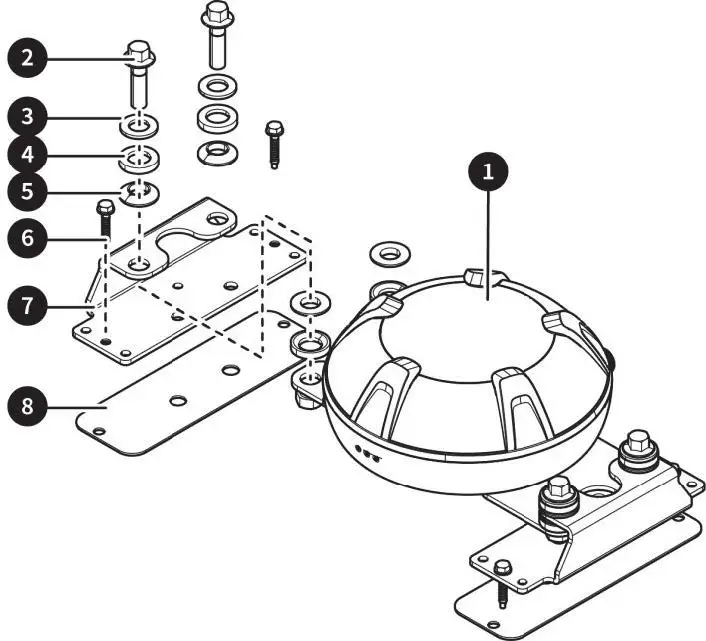
| ʻAʻole. | inoa | Qty. | ʻŌlelo |
| 1 | GNSS loaʻa | ||
| 2 | Hexagon flange bolt M8x3Q | 4 | |
| 3 | Flat washer class A MS | 4 | |
| 4 | Spherical washer | 8 | |
| 5 | Mea holoi liʻiliʻi | 8 | |
| 6 | Paʻi wili | 4 | |
| 7 | GNSS receiver bracket | 2 | |
| 8 | 3M sticker | 4 |
Hoʻokomo ʻanuʻu
Install the GNSS receiver bracket on the top of the agricultural machinery with the flat washers, spherical washers, taper washers, and tapping screws or 3M stickers. The installation method is as follows:
- Step 1: The GNSS receiver is pre-installed on the bracket. Tighten the hexagon flange bolts 1. Use an appropriate number of washers 2 on both sides to ensure that the GNSS receiver is level.
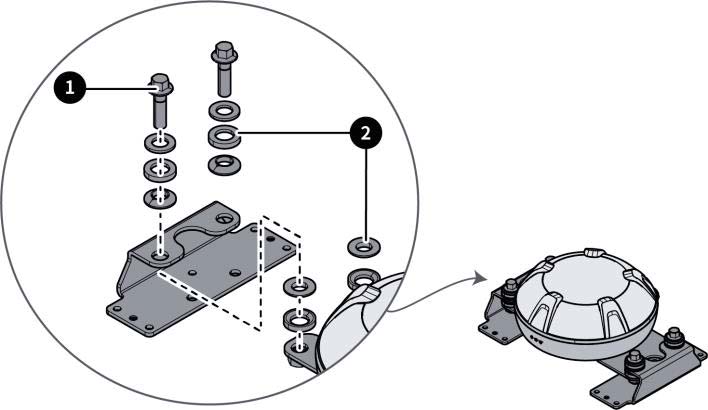 Step 2: Use the tapping screws or 3M stickers, whichever suitable, to fix the GNSS receiver on the top.
Step 2: Use the tapping screws or 3M stickers, whichever suitable, to fix the GNSS receiver on the top.
- Method 1: Use tapping screws 1 to fix the GNSS receiver bracket 2 on the top of the agricultural machinery.

- Method 2: Use the 3M stickers 1 to fix the GNSS receiver bracket 2.
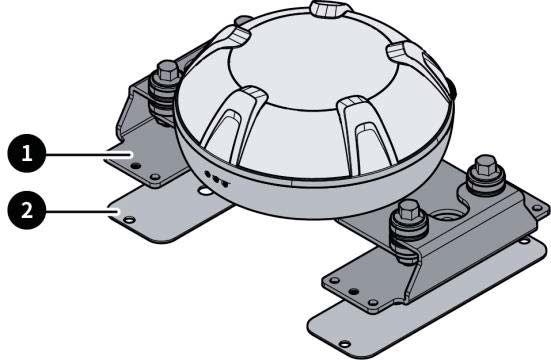
- Method 1: Use tapping screws 1 to fix the GNSS receiver bracket 2 on the top of the agricultural machinery.
Installing the Terminal
Nā mea waiwai 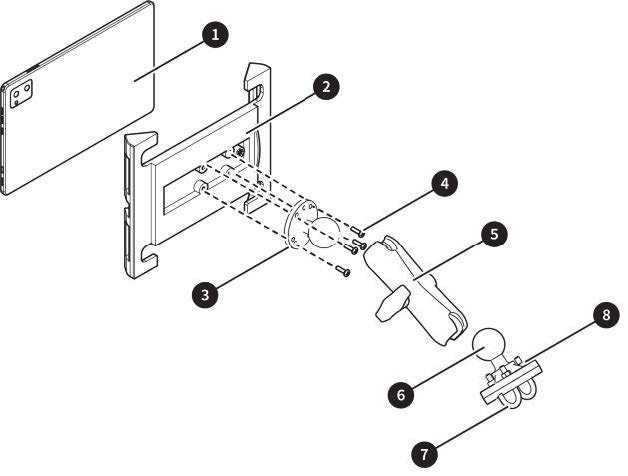
| ʻAʻole. | inoa | Qty. | ʻŌlelo |
| 1 | Terminal | 1 | |
| 2 | Paʻa paʻa | 1 | Provided with the terminal |
| 3 | Holder bracket base | 1 | |
| 4 | ʻūlū | 4 | |
| 5 | Palena mea hoʻopili | 1 | |
| 6 | Kahua paʻa | 1 | |
| 7 | U-hoʻopaʻa i | 2 | |
| 8 | Nut | 4 |
Nā ʻanuʻu hoʻokomo
- Step 1: Select an appropriate position inside the cab for easy operation. Then, fix the bracket base 3 there with U-bolts 1 and nuts2.
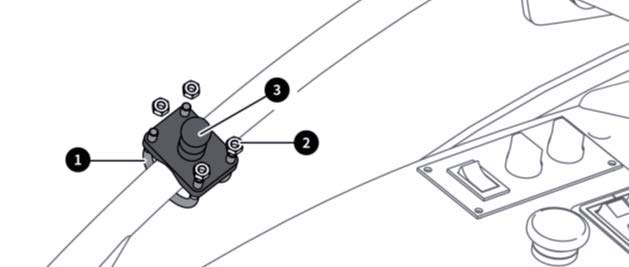
- Step 2: Fix the bracket base 1 on the back of the terminal holder bracket 2 with screws and place in and fix the terminal 3 . Rotate the handle of the adapter bracket4 counterclockwise to loosen the ball socket, and then install the ball joint on the back of the terminal into the ball socket of the bracket.
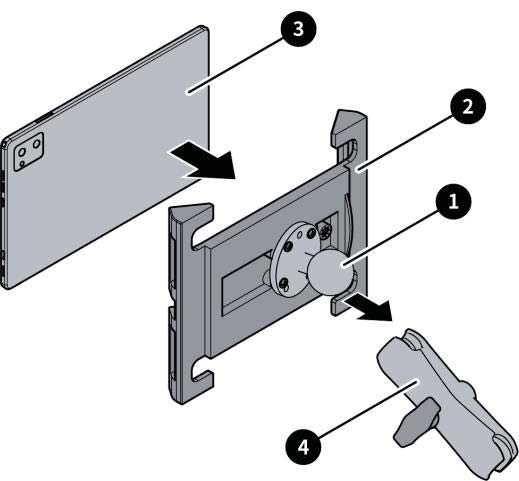
- Step 3: Install the ball joint 2 of the base into the other ball socket of the adapter bracket 1 , and rotate the handle clockwise to firmly fix the terminal.
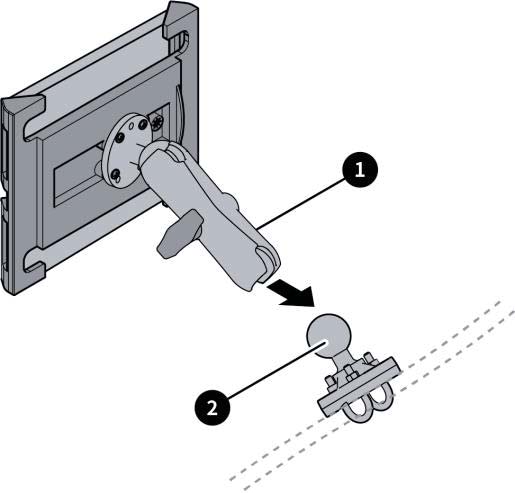
Ke kau ʻana i ke Kāleka SIM
Nā mea waiwai
| ʻAʻole. | inoa | Qty. | ʻŌlelo |
| Kāleka SIM | The customer needs to prepare a micro-SIM card. |
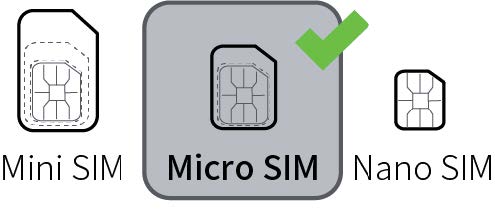 Nānā:
Nānā:
- Ensure that you have data traffic for the SIM card.
- Check whether you need to set the APN and network type according to the user manual after installing the SIM card. If you need to, turn on the terminal and configure them in the Android system settings.
Kaʻina hana hoʻokomo
- Locate the SIM card slot, insert the ejector into the hole on the slot, and press to eject the SIM card tray.
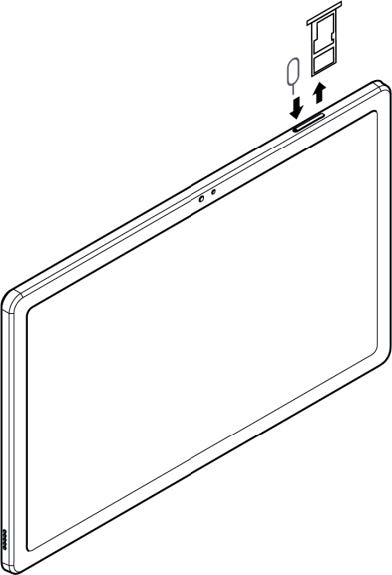
- Take out the SIM card tray, and put the SIM card into the tray. Be careful with the direction and ensure that the SIM card is level and fixed.
- Inset the SIM card try into the slot.
Installing Wiring Harnesses
Nā mea waiwai 
| ʻAʻole. | inoa | Qty. | ʻŌlelo |
| 1 | Cab charger cable | 1 | |
| 2 | Uea mana nui | 1 | |
| 3 | GNSS receiver cable | 1 | |
| 4 | Cab charger | 1 |
Kaʻina hana hoʻokomo
Connect the cables according to the figure below.
Nānā:
- Turn off the agricultural machinery or its battery before plugging or unplugging cables or connecting devices.
- Avoid hot areas and sharp edges when wiring.
- Connect the main power cable to the negative electrode of the power supply, then to the positive electrode, and finally to other cables.
Manaʻo manaʻo:
- Route the GNSS receiver cable from the vehicle roof, for example, the sunroof, into the cab and to the right front of the seat.
- Connect the negative electrode of the main power cable to the negative electrode of the power supply, and do not connect the positive electrode to the power supply. Then, use nylon cable ties to fix the cable on the right side of the vehicle and into the cab from the right front.
- Connect one end of the cab charger cable to the main power cable and the other end to the GNSS receiver cable.
- To charge the terminal, connect the cab charger to the round end of the cab charger cable and connect port A of the USB A-Type-C cable to the cab charger (item Din the figure below) and the Type-C port to the terminal. If the agricultural machinery is equipped with a cigarette lighter (item E in the figure below), you can get power directly from it.
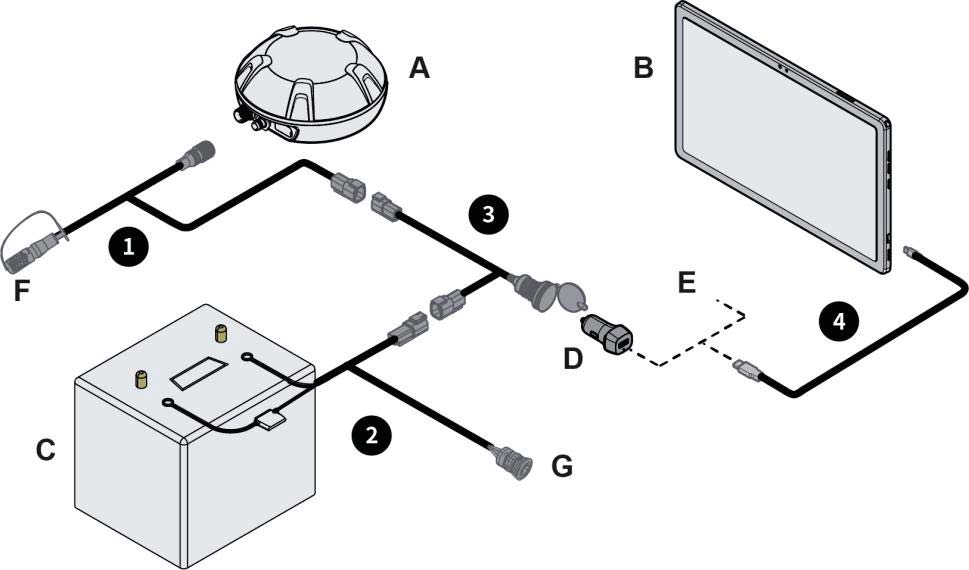
| l | GNSS receiver cable | A | GNSS loaʻa | E | Cab charger |
| 2 | Uea mana | B | Terminal | F | awa lekiō |
| 3 | Cab charger cable | C | Lako ikehu | G | Hoʻololi mana |
| 4 | USB A-Type-C cable | D | Cab charger |
Hoʻolaha kope kope:
SMAJAYU reserves the copyright for this manual and all contents herein. No part of this manual may be reproduced, extracted, reused, and/or reprinted in any form or by any means without the prior written permission of SMAJAYU.
Hiki ke hoʻololi i kēia lima me ka ʻole o ka leka hoʻomaopopo.
Hoʻoponopono:
| Manao | Lā | wehewehe |
| Rev. 1.0 | 2024.05 | Hoʻokuʻu mua |
ʻO ka hoʻonohonoho ʻana i nā ʻōnaehana
Kūlana Paena
- Ensure that the agricultural machinery is in good condition and all parts are functional.
- Ensure that there are no signal obstructions such as tall trees and buildings around the site.
- E hōʻoia ʻaʻohe kiʻekiʻe-voltagnā laina mana i loko o 150 m a puni ke kahua.
- The site ground should be level and no smaller than 50 m x 10 m.
- Pono e loaʻa i ke kahua ka papa pōhaku palahalaha a i ʻole ke kahua asphalt.
- Pono e hoʻokō ʻia ke komisina ma nā alanui lehulehu ʻole. E hōʻoia i ka noho ʻole ʻana o nā limahana pili ʻole a puni ka excavator i ka wā e hana ai e pale i nā ulia.
Mana-Ma
E nānā ma mua o ka ho'ā ʻana
- E nānā inā pili pono ka mana.
- E hōʻoia inā loaʻa ka voltage oluolu.
Check After Power-on
E ho'ā i ka pahu hoʻomalu, a nānā i ka hoʻomaka maʻamau o ka polokalamu ʻōnaehana.
Hoʻolālikelike ʻia
Calibrate the implement parameters if there is any overlap or skip between guidance lines. Choose Menu > Device Settings > Calibration on the terminal, select whether to calculate the correction automatically or manually, and then tap Calibrate. The correction will be added to the accumulated correction. You can also tap the button again for correction. Tap Clear if you need to clear the correction and the accumulated correction.
The preceding commissioning procedure ensure that accurate navigation is available. Before proceeding, do the following:
Check the signal source connection – Check the task configuration – Create or select fields → Create or select a task →Create or select a boundary → Create or select a guidance line → Check the implement configuration→ Obtain the heading – Start the operation. For details, see the Agricultural Machinery Guidance System Software User Manual
Pākuʻi
Nā ʻōlelo kikoʻī paʻa
| ʻAʻole. | ʻāpana | Nā kikoʻī |
| 1 | Terminal | Size: 248x157x8mmBasic configuration: 10.36-inch capacitive touchscreen, LED backlight, 12oox2000 pixels, 400 nits, 6 GB RAM, 128 GB ROM Power supply: 5 V Signal sources: radio, satellite, and 4G; Wi-Fi and Bluetooth connection Operating temperature: -10°C to +55°CStorage temperature: -20°C to +70°C |
| 2 | GNSS loaʻa | Nui: 162×64.5 mm Frequency: GPS LlC/ A, LlC, L2P(W), L2C, L5; GLONASS L1 and L2; BDS Bll, B2I, B31, BlC, and B2a;Galileo El, E5a, E5b, and SBAS Hana voltage: 9 V a 36 V Ke hana nei i kēia manawa: <300 mA Operating temperature: -20°c to +70°C Storage temperature: -40°C to +85°CIP rating: IP66 |
Palapala hōʻoia
- All users who purchase the agricultural machinery guidance system enjoy a 2-year warranty, including lifetime free updates for the system software. The warranty period starts from the date of product sale (invoice issuance).
- Within the warranty period of the agricultural machinery guidance system, any damaged part will be repaired or replaced by the dealer free of charge if the warranty for the damaged part is valid. If the damaged part is out of the warranty period, the user needs to purchase a new part, and the dealer will repair the system for the user.
- If the agricultural machinery guidance system is damaged due to improper use, maintenance, or adjustment of the user, or other non-quality reasons during the warranty period, the user needs to purchase a spare part, and the dealer or SMAJAYU will repair the system free of charge.
- The dealer will provide free installation, debugging, training, and service within the warranty period of the agricultural machinery guidance system.
- SMAJAYU s reserves the right of interpretation for this warranty commitment.
E heluhelu ma mua o ka hoʻohana ʻana:
 Install in strict accordance with this manual.
Install in strict accordance with this manual.
 Inā he mau nīnau kāu i ka wā e hoʻohana ai, e kelepona i nā limahana lawelawe.
Inā he mau nīnau kāu i ka wā e hoʻohana ai, e kelepona i nā limahana lawelawe.
Hoʻolele:
- ʻO nā huahana, nā lawelawe, a me nā hiʻohiʻona i kūʻai ʻia e ka ʻaelike. ʻAʻole paha i loko o ke kiko o kāu kūʻai a hoʻohana ʻana i nā huahana a pau a i ʻole ʻāpana o nā huahana, nā lawelawe, a me nā hiʻohiʻona i wehewehe ʻia ma kēia manual. Inā ʻaʻole i kuhikuhi ʻia i loko o ka ʻaelike, hāʻawi ʻia nā ʻike āpau o kēia manual "AS IS" me ka ʻole o nā palapala hōʻoia o kēlā me kēia ʻano, hōʻike a i ʻole.
- The content of this manual is subject to change due to product upgrades and other reasons. SMAJAYU reserves the right to modify the content of this manual without notice.
- Hāʻawi kēia manual i ke alakaʻi no ka hoʻohana ʻana i kēia huahana. Ua hana ʻia nā hana a pau i ka hoʻomākaukau ʻana i kēia manual e hōʻoia i ka pololei o ka ʻike, akā ʻaʻohe ʻike i loko o kēia manual e lilo i palapala hōʻoia o kēlā me kēia ʻano, hōʻike a i ʻole.
Olelo mua
Thank you for using this SMAJAYU product. This manual provides detailed hardware installation guide. If you have any questions, contact the local dealer.
Ke kumu a me nā mea hoʻohana i manaʻo ʻia
Hōʻike kēia manual i nā hiʻohiʻona kino, nā kaʻina hana hoʻonohonoho, a me nā kikoʻī ʻenehana o ka huahana a me nā kikoʻī a me ka hoʻohana ʻana i nā wili a me nā mea hoʻohui. Ma muli o ka manaʻo ua kamaʻāina nā mea hoʻohana i nā huaʻōlelo a me nā manaʻo e pili ana i kēia huahana, ua manaʻo ʻia kēia manual no nā mea hoʻohana i heluhelu i ka ʻike ma mua a loaʻa ka ʻike i ka hoʻonohonoho ʻana a me ka mālama ʻana.
Kākoʻo ʻenehana
SMAJAYU official webkahua: www.smajayu.com For detailed information on installation, use and function updates, please contact us at tech@smajayu.com a kākoʻo@smajayu.com.
FFCC statements
This device (FCC ID: 2BH4K-SMA10GPS) complies with part 15 of the FCC rules. Operation is subject to the following two conditions:
- ʻAʻole hiki i kēia mea hana ke hoʻopilikia ʻino, a
- Pono kēia hāmeʻa e ʻae i nā hoʻopaʻapaʻa i loaʻa, me ka hoʻopili ʻana i hiki ke hana ʻole ʻia.
HOOLAHA: The manufacturer is not responsible for any radio or TV interference caused by unauthorized modifications or changes to this equipment. Such modifications or changes could void the user’s authority to operate the? equipment.
HOOLAHA: Ua hoʻāʻo ʻia kēia mea hana a ua ʻike ʻia e hoʻokō i nā palena no kahi hāmeʻa kikohoʻe Papa B, e like me ka ʻāpana 15 o nā Rula FCC. Hoʻolālā ʻia kēia mau palena no ka hāʻawi ʻana i ka pale kūpono mai ka hoʻopilikia ʻino ʻana i kahi hoʻonohonoho hale. Hoʻohana kēia mea hana a hiki ke hoʻomālamalama i ka ikehu alapine lekiō a, inā ʻaʻole i hoʻokomo ʻia a hoʻohana ʻia e like me nā kuhikuhi, hiki ke hoʻopilikia i nā kamaʻilio lekiō. Eia nō naʻe, ʻaʻohe mea e hōʻoiaʻiʻo ʻaʻole hiki ke keakea i kahi hoʻonohonoho. Inā hoʻopilikia kēia mea hana i ka lekiō a i ʻole ke kīwī, hiki ke hoʻoholo ʻia ma ka hoʻopau ʻana i nā mea hana, paipai ʻia ka mea hoʻohana e hoʻāʻo e hoʻoponopono i ka hoʻopili ʻana ma o hoʻokahi a ʻoi aku paha o kēia mau ana:
- Hoʻonohonoho hou a hoʻoneʻe paha i ka antenna e loaʻa ana.
- E hoʻonui i ka kaʻawale ma waena o nā mea hana a me ka mea hoʻokipa.
- E hoʻohui i nā mea hana i kahi puka ma kahi kaapuni ʻokoʻa mai ka mea i hoʻopili ʻia ai ka mea hoʻokipa.
- E kūkākūkā i ka mea kūʻai aku a i ʻole kekahi mea loea lekiō/TV no ke kōkua.
Federal Communication Commission (FCC) Radiation Exposure Statement When using the product, maintain a distance of 20cm from the body to ensure compliance with RF exposure requirements. Changes or modifications not expressly approved by the party responsible for compliance could void the user’s authority to operate the equipment.
©SMAJAYU. All rights reserved.
FAQ
- Nīnau: He aha kaʻu e hana ai inā pilikia au i ka wā e hoʻohana ai i ka hāmeʻa?
- A: If interference occurs, try adjusting the device’s position or moving it to a different location to minimize interference. Ensure no unauthorized modifications have been made.
- Nīnau: Pehea e hiki ai iaʻu ke hōʻoia i ka hoʻokō ʻana i nā koi hoʻolaha RF?
A: Maintain a distance of at least 20cm between the device and your body while using it to comply with RF exposure requirements. - Nīnau: Hiki iaʻu ke hoʻololi i ka mea hana no ka hana maʻamau?
A: Only make modifications that are expressly approved by the responsible party for compliance to avoid voiding your authority to operate the equipment.
Palapala / Punawai
 |
SMAJAYU SMA10GPS GPS Tractor Multi Function Navigation System [pdf] Palapala Aʻo SMA10GPS, SMA10GPS GPS Tractor Multi Function Navigation System, GPS Tractor Multi Function Navigation System, Multi Function Navigation System, Navigation System |
